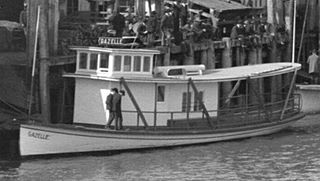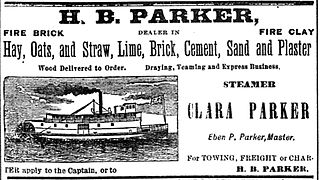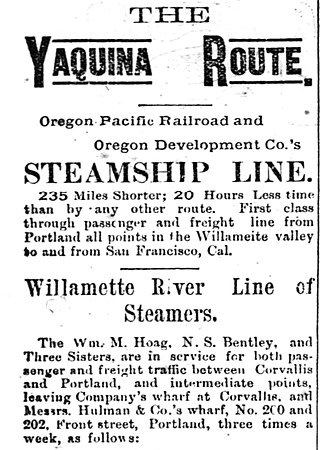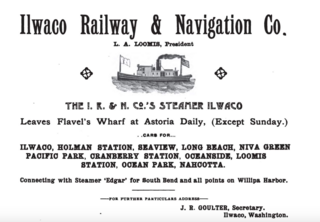
Wide West was a steamboat that served in the Pacific Northwest of the United States. It had a reputation as a luxury boat of its days.
Willapa Bay is a large shallow body of water near the Pacific Ocean in southwestern Washington. For a number of years before modern roads were built in Pacific County, Washington, the bay was used as the means of travel around the county, by powered and unpowered craft, including several steamboats.

The history of steamboats on the Oregon Coast begins in the late 19th century. Before the development of modern road and rail networks, transportation on the coast of Oregon was largely water-borne. This article focuses on inland steamboats and similar craft operating in, from south to north on the coast: Rogue River, Coquille River, Coos Bay, Umpqua River, Siuslaw Bay, Yaquina Bay, Siletz River, and Tillamook Bay. The boats were all very small, nothing like the big sternwheelers and propeller boats that ran on the Columbia River or Puget Sound. There were many of them, however, and they came to be known as the "mosquito fleet."

Yaquina Bay, like Coos Bay, is a shallow coastal bay on the Oregon Coast in the Pacific Northwest of North America. The principal town on Yaquina Bay is Newport, Oregon. The Yaquina River flows into the bay. Until modern roads reached Newport in the late 1920s, the principal transportation method to and from Newport was by ship or boat.

Olympian was a large side-wheel inland steamship that operated in the Pacific Northwest and Alaska. Olympian operated from early 1884 to late 1891 on the Columbia River, Puget Sound, and the Inside Passage of British Columbia and Alaska.

General Miles was a steamship constructed in 1882 which served in various coastal areas of the states of Oregon and Washington, as well as British Columbia and the territory of Alaska. It was apparently named after US General Nelson A. Miles.

T.M. Richardson was a steamboat built in 1888 at Oneatta, Oregon, which served on Yaquina Bay and on the Yaquina River from 1888 to 1908. This vessel was commonly known as the Richardson or the T.M.

Tressa May was a steamboat that was operated in the Yaquina Bay region of Oregon from 1883 to 1888.

Ocean Wave was a steamboat that was operated from 1891 to 1897 on the Columbia River, from 1897 to 1899 on Puget Sound and from 1899 to 1911 as a ferry on San Francisco Bay. Ocean Wave is perhaps best known for transporting summer vacationers from Portland, Oregon to seaside resorts near Ilwaco, Washington during its service on the Columbia River. This vessel is also known for being the first ferry placed in service by the Atchison, Topeka and Santa Fe Railway.
W.H. Harrison was a steam schooner that operated from 1890 to 1905 on the coast of Oregon, the lower Columbia River, and southwest Washington state. At that time the salmon cannery industry was one of the major businesses of the coast. W.H. Harrison, while also carrying passengers and transporting general freight and lumber, was one of a number of steamers supplying materials to canneries along the coast, and transporting cases of canned salmon from the canneries.

Emma Hayward commonly called the Hayward, was a steamboat that served in the Pacific Northwest. This vessel was once one of the finest and fastest steamboats on the Columbia River and Puget Sound. As newer vessels came into service, Emma Hayward was relegated to secondary roles, and, by 1891, was converted into a Columbia river tow boat.

Harvest Queen was the name of two stern-wheel steamboat built and operated in Oregon. Both vessels were well known in their day and had reputations for speed, power, and efficiency.The first Harvest Queen, widely considered one of the finest steamers of its day, was constructed at Celilo, Oregon, which was then separated from the other portions of the navigable Columbia River by two stretches of difficult to pass rapids.

Fanny Patton was a stern-wheel driven steamboat that operated on the Willamette River, in Oregon, starting in August 1865. This steamer operated from 1865 to 1880 for various owners, and was a considered a profitable vessel. The steamer was named for the daughter of businessman Edwin N Cook, Frances Mary "Fannie" Cooke (1837–1886). Edwin N. Cook was one of the principals of the People's Transportation Company.

Telephone was a sternwheel-driven steamboat built in 1884 by Captain Uriah Bonsor "U.B." Scott for service on the Columbia River. Reputedly the fastest steamboat in the world in its time, Telephone served on the Columbia River and San Francisco Bay. Telephone was rebuilt at least twice. The first time was after a fire in 1887 which nearly destroyed the vessel. The reconstructed and much larger second vessel was sometimes referred to as Telephone No. 2. The third vessel, Telephone No. 3, built in 1903 and using components from the second steamer was larger but little used during its time on the Columbia river.

Gazelle was a gasoline powered launch that operated on the Willamette and Columbia river from 1905 to 1911. For short periods of time Gazelle was operated on the Oregon Coast, on Yaquina Bay and also as an off-shore fishing vessel, in the Coos Bay area.

Governor Newell was a sternwheel-driven steamboat that operated from 1883 to 1902 in the Pacific Northwest.

Clara Parker was a sternwheel-driven steamboat which was operated on the lower Columbia and lower Willamette rivers in the 1880s. The steamer ran for about ten years out of Astoria, Oregon in towing and jobbing work. In 1890 Clara Parker was rebuilt and renamed Astorian.

N.S. Bentley, commonly referred to as simply Bentley, was a stern-wheel driven steamboat that operated on the Willamette rivers. Launched in East Portland in December 1886, Bentley ran until 1896, when it was rebuilt and renamed Albany. Bentley was owned by the Oregon Pacific Railway, and was used as part of a rail and marine link from Portland to San Francisco, running down the Willamette, then to Yaquina Bay, and then by ocean steamer south to California. In 1896, Bentley was rebuilt and renamed Albany.

Ilwaco was a small riverine and coastal steamship built in 1890 which was operated as a passenger vessel for the Ilwaco Railway and Navigation Company, and later served in other roles, including tow and freight boat, cannery tender and fish packing vessel. Ilwaco was originally named Suomi.

The Callendar Navigation Company, sometimes seen as the Callendar Transportation Company, started in business in the early 1900s. Callendar was formed in the early 1900s, and was based in Astoria, Oregon. Callender was to become one of six large towing companies of the Columbia and Willamette rivers in the early decades of the 1900s, the others being Shaver Transportation, Smith Transportation, Hosford, Knappton Towing Co., and Willamette and Columbia River Towing Co. In 1922, Callendar Navigation merged with Knappton Towboat Co., which existed, with a name change in 1990, and which became part of Foss Marine in 1993.





















